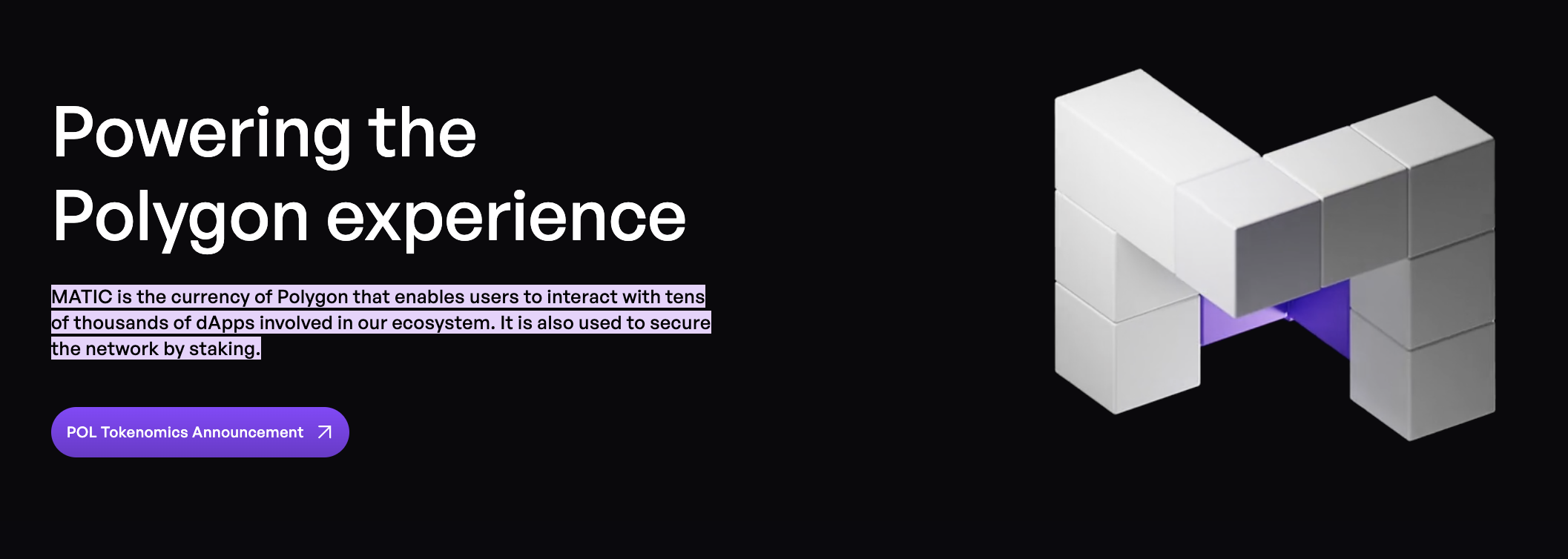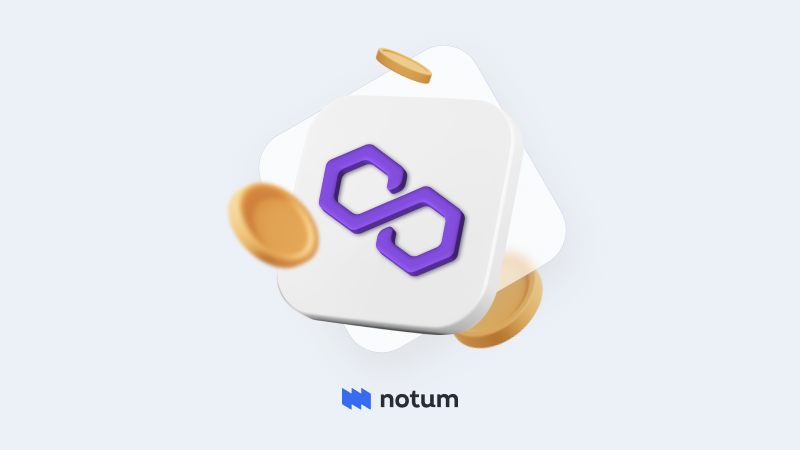What Is Polygon Network?
Polygon is a sidechain or Layer 2 scaling solution that provides various tools to increase the speed, reduce the cost and complexity of transactions in blockchain networks. Since Polygon layer 2 utilizes the Ethereum blockchain and also connects Ethereum-based projects, its use affects the scalability and flexibility of the blockchain.
Interesting fact! A layer-2 solution is a blockchain that runs in parallel with the main network, but processes transactions outside of it. Thus, L2 solutions increase throughput and reduce gas fees.
In addition, the Polygon blockchain includes a series of protocols that are designed to solve Ethereum's scalability problems. Polygon processes transactions on an Ethereum-compatible blockchain and then sends them to the main Ethereum blockchain, reducing the network’s load. In addition, Polygon significantly speeds up transactions and reduces transaction costs to less than a cent. Polygon’s address can be found here.
Important! Polygon was founded in 2017 as Matic Network. During two rounds of startup funding, the platform managed to raise more than $450 million.
Polygon Network now provides an Ethereum-based platform for other blockchain projects and allows users to leverage any Ethereum dApps without thinking about network congestion. You can stay informed about Polygon network status here.
What Is MATIC?
MATIC is an ERC-20 token and Polygon's native cryptocurrency. MATIC is needed to pay Polygon Network fees, as well as staking rewards, governance goals, and user interaction with housands of dApps participating in the Polygon ecosystem.
Interesting fact! MATIC has a limited supply of 10 billion coins, and in July 2024, 9.8 billion are already in circulation.
MATIC crypto also plays a huge part in Polygon PoS. When using applications or making transactions on the network, users pay a small fee in MATIC, which incentivizes validators to verify these transactions.
As known, Polygon uses a proof of stake mechanism. Thus, by staking Polygon’s crypto, users not only earn rewards, but also contribute to Polygon’s security.
Important! As of July 2024, the token price is $0.5155.

Source: Polygon
How Does Polygon Network Work?
It’s no secret that as L1 blockchain, Ethereum has issues that most blockchains face - specifically decentralization, security and scalability.
Since Ethereum has put the main focus on decentralization and security, the damage has come at the expense of scalability, making transactions expensive and slow. This is where Polygon's L2 solution comes in, helping to provide faster transaction speeds and lower costs than Ethereum.
Important! While Ethereum can process 14 transactions per second, Polygon can handle up to 7,000 TPS, making it a faster and cheaper solution.

Source: Polygon
As a multi-level platform, Polygon uses a huge number of sidechains, each of which is necessary to cost-effectively eliminate interference with the main platform.
Speaking about the Polygon architecture, the basis of the network is the Polygon software development kit (SDK), which is necessary for creating Ethereum-compatible dApps as sidechains and connecting them to the main blockchain.
Sidechains and Plasma
Sidechains can be described as unique blockchains tied to the Ethereum blockchain. Their goal is to support the DeFi protocols available on Ethereum.
Important! To build sidechains, developers usually use Plasma Chain and zk-Rollup сonstruction scalability methods.
The Plasma blockchain is a network of independent child chains that function as separate blockchains. Each of the child chains has its own block verification mechanisms, but at the same time remains tied to the underlying blockchain. What makes Plasma unique is that each child chain has a specific transaction processing purpose and can have different settings than the parent chain, allowing for greater efficiency and flexibility.
At the moment, Polygon has 3 public chains - Polygon PoS, Polygon zkEVM, Polygon Miden, as well as one app-specific chain - Polygon CDK.

Source: Polygon
Proof-of-Stake Consensus Mechanism
To create new MATIC tokens and secure the network, Polygon uses a proof-of-stake consensus mechanism based on people staking their tokens and receiving rewards for maintaining the network and validating transactions.
PoS on Polygon allows users to be either a validator or delegator.
- Validators check new transactions on the Polygon network and add them to the blockchain, receiving MATIC tokens and a portion of commissions as a reward. However, to become a validator, the user must run a full-time node and stake at least one MATIC.
- Delegators are users who stake their tokens through validators, which is an easier option for generating income. However, validators often take a small commission from delegates' rewards for their work.
How Can I Use Polygon Network?
Now, instead of a simple scaling solution, Polygon has evolved into a fairly broad and complex ecosystem, where users and developers have a wide range of use cases. In simple terms, you can perform almost all the same actions as on Ethereum, only with minimal fees and improved speed.
Users and developers can utilize the Polygon Network to launch Ethereum-compatible blockchains, mint NFTs, and leverage a huge number of Ethereum-based dApps. Besides users can stake MATIC as validators and delegators and receive income for taking part in the network’s development.
Interesting fact! Polygon is the basis for a huge number of projects related to making money on cryptocurrency, such as Curve or Aave, as well as decentralized exchanges like SushiSwap.
Benefits of Using Polygon Network
- Transaction costs. While there are expensive transactions on Ethereum, Polygon offers a fairly low fee for using the platform of around $0.01.
- Scalability. Polygon provides a fairly high throughput, processing thousands of transactions per second (TPS), which significantly reduces congestion compared to Ethereum. So while Ethereum can process only 14 TPS, Polygon achieves up to 7,000 TPS.
- Speed. Polygon (MATIC) network maintains high transaction processing speeds through the use of a PoS consensus mechanism. Since PoS completes confirmation in a single block, average block processing time takes only 39.7 seconds.
- Interoperability. Since Polygon supports interoperability with other blockchains and Ethereum-compatible chains, it enables seamless interaction and transfer of assets between different platforms.
- Safety. As Polygon uses Ethereum's security through L2 solutions and validators that verify transactions, it provides a secure environment for users and developers.
Thus, Polygon's low fees, scalability and low transactions make it an excellent solution for users, while its extensive tools and SDKs also attract investors around the world.
How to Invest in Polygon?
Polygon is considered a good investment since it is the leading layer-2 solution for Ethereum and offers a solution to existing problems in the network, such as speed, scalability and transaction costs.
MATIC, in turn, is a fairly large crypto that ranks 21st in popularity in the world, while its market capitalization exceeds $5 billion.
Investing in MATIC is quite simple. The easiest way is to find a DEX or CEX that supports the token - for example Binance, Kraken, Coinbase and many others, and connect your wallet like Metamask, Trustwallet, etc. When choosing an exchange, pay attention to security, fees, user-friendly interface, etc.
Another way to make money on MATIC is through investment strategies, such as staking, where you can be a delegator or run a validator node, yield farming, lending and borrowing, liquidity mining and many others.
Important! You can use Notum to explore different strategies and invest in MATIC.
